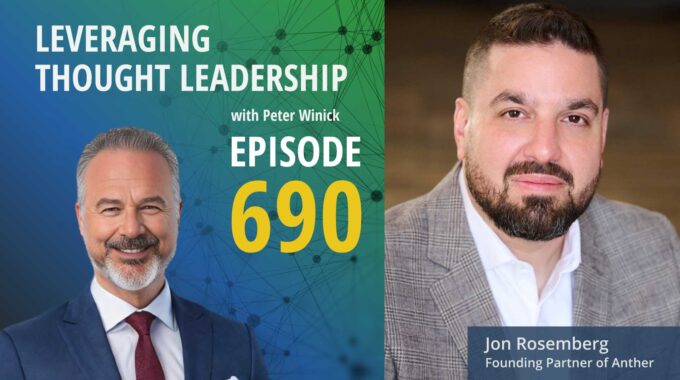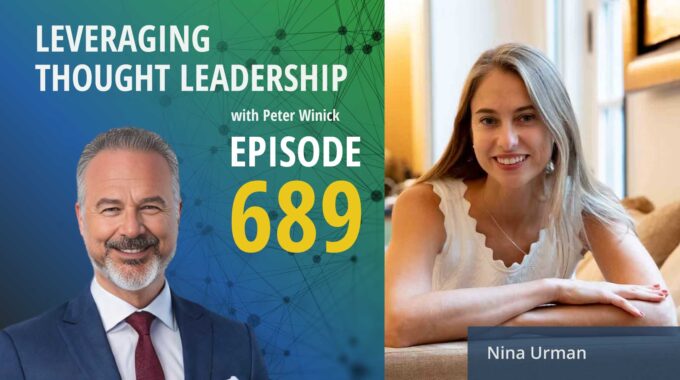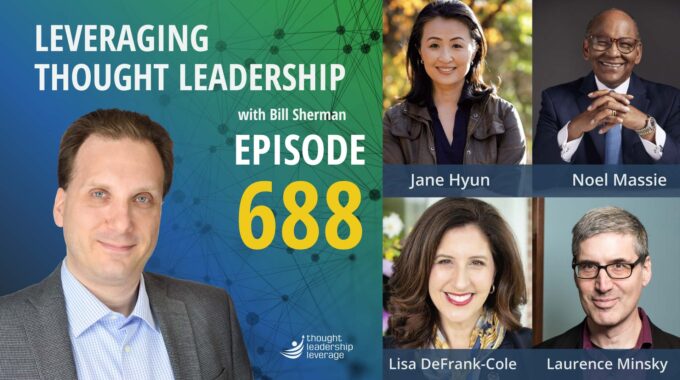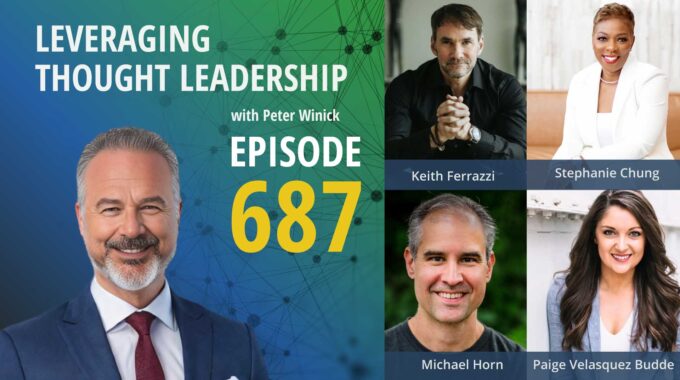A practical framework for leaders who want clarity and performance This episode defines thriving at…
Scaling Leadership: Making Coaching Accessible at Every Level | Kristin Lytle
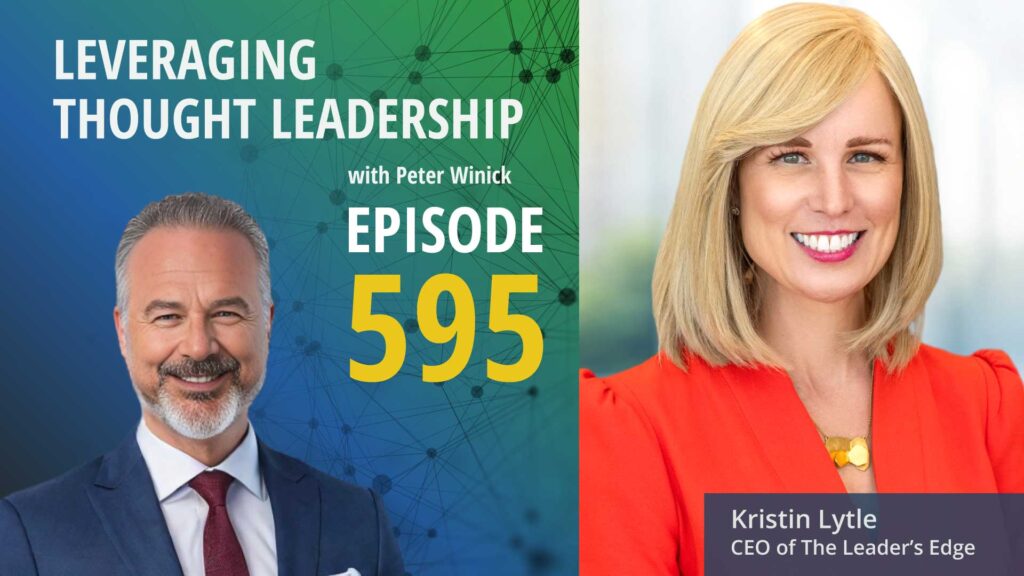
Shifting from Coaching Individuals to Elevating the Entire Workforce
In this episode, Kirstin Lytle shares how her organization is elevating leaders to their full potential and making the tools they offer more widely accessible.
Join host Peter Winick as he dives into a compelling conversation with Kristin Lytle, CEO of The Leader’s Edge, an executive coaching firm transforming senior leadership. Kristin’s journey to becoming a thought leader is rooted in her own experiences of self-doubt, which ignited her passion for helping others articulate their ideas and reach their full potential.
Kristin shares how her firm elevates potential within organizations by offering tools, executive coaching, and leadership development programs that unlock leaders’ full potential. But Kristin doesn’t stop there. She’s on a mission to make executive coaching accessible to the entire organization—not just the top tier. By focusing on building a culture of high integrity and crowding out low-integrity leaders, her team ensures that toxic behaviors are as unacceptable as an obvious safety hazard in the workplace.
Kristin also discusses the importance of leveraging the insights of her team. Through regular coaches’ roundtables, expert input, and staying attuned to client needs, The Leader’s Edge is constantly evolving. The goal? To identify universal leadership challenges and create scalable solutions that blend online learning with executive coaching and community support.
As Kristin transitions her firm from a practice to a full-fledged business, she’s learned that allocating top talent is as crucial as managing finances. But perhaps the most profound insight she shares is the role fear plays in leadership behavior—fear of judgment, fear of looking foolish, and fear of not knowing enough. These fears, she argues, often drive leaders more than they realize.
Three Key Takeaways:
Unlocking Potential at All Levels: Kristin Lytle emphasizes the importance of making leadership coaching accessible to the entire organization, not just the top executives. By crowding out low-integrity leaders and fostering a culture of high integrity, organizations can ensure that everyone has the opportunity to reach their full potential.
Scalability Through Universal Solutions: The Leader’s Edge focuses on identifying consistent leadership challenges, like influence, that cut across industries and regions. By developing scalable solutions, such as blended learning programs, they make impactful leadership development available to a broader audience.
Fear as a Driving Force in Leadership: One of Kristin’s key insights is that fear—whether it’s fear of judgment, looking foolish, or not knowing enough—often drives leadership behaviors more than we might realize. Recognizing and addressing these fears is crucial for effective leadership.
Kristin’s team at The Leader’s Edge is working hard to make work a better and more satisfying place to be. But what is the secret to changing a company’s culture? Find out in this article by Thought Leadership Leverage COO Bill Sherman.
Transcript
Peter Winick And welcome, welcome, welcome. This is Peter Winick. I’m the founder and CEO at Thought Leadership Leverage. And you’re joining us on the podcast today and which is leveraging thought leadership today. My guest is Kristen Lytle, and she’s got a really cool bio and I’m going to go backwards. So it says she’s an avid reader, mediocre musician, dog lover, kayaker, biker, Francophile and all things nerdy you’d expect from a former academic decathlete. So she’s also the CEO of a group called The Leaders Edge and has had a extensive stint in corporate America. But I want to but I’d work that one backwards. So welcome aboard today.
Kristin Lytle Thank you. Thank you. And I wouldn’t put it out there if I wasn’t willing to share it.
Peter Winick Yeah, right, exactly. Exactly. So tell me about your journey. How did you get here as a thought leader?
Kristin Lytle Sure. So there’s a number of different points in careers and such, but I would say as far first thought, Leader, I’m going to start actually from the back as well of did you probably kid it? And the second of four I had the typical older sister who was incredibly booksmart, incredibly sharp, and by comparison, I thought I wasn’t that smart for many, many years. And it took a little while to figure that out for my own self. I remember I was at Koehler Company and went through their cognitive testing as part of a potential assessment, and I was convinced I was going to bomb the whole thing. And I’m like, my gosh, certain things are in the 90. Smart. I have capabilities. That being said, I was I’ve always been able to think to myself and look back at a times in my life where I didn’t speak up. I didn’t put myself forward because I always thought I wasn’t smart enough or I thought I wouldn’t figure something out. And ever since then, I’ve been very passionate about how do I articulate things? How do I bring these abstract ideas to people in a way that they can understand it, in a way they can quickly apply it to their lives so that they themselves are not holding themselves back from their full potential. Because when I think about it, there’s 1 or 2 instances I can think of a time in school when I thought I didn’t get something completely right, got a tutor. He explained it slightly differently. I’m like, that’s it. my gosh, I get it as easy now. And so I think that’s where it really started, was this idea of I never want for someone to hold themselves back because they think they don’t get something or they think it’s they’re not smart enough to get it. So I find ways to articulate so that people can advocate for themselves and accelerate their own development.
Peter Winick So what does that look like in terms of the business? So who pays you to do what that is? I get the I love the back story and I think there are probably a lot of in similar situations at any moment in time in the corporate arena, whether it’s birth order or being surrounded by people that are really impressive or smart or a little bit of imposter syndrome kicked in. But so what’s the problem that you’re solving for who?
Kristin Lytle What we’re solving is we’re helping organizations to ensure they’re not wasting potential inside of their organizations. So we have various solutions that help individuals do that to ensure leaders are unlocking their full potential. So we have executive coaching as well as we have different leadership development programs. But as you and I spoke in a previous conversation, I love your model of something, a practice versus a business. Right. I would say right now, leaders that we are very much so on the verge of going from a practice and to you and I’ll let you’re paraphrase that to make sure I don’t mess that one up. But I would say that we’re on the verge of going into a business because where we are headed is this idea of how can we help more people on a more scalable version versus having a be simply is valuable and is potent of a tool, is executive coaching is right, not accessible for everybody. Yeah. So let’s talk.
Peter Winick About that from my perspective, and there’s not an exact science to this, but a practice ultimately is you or someone needs to be in the room or in the zoom for the ideas to be exchanged and therefore dollars to be exchanged and therefore impact to be had. Right. And they’re paying for. The expertise, but they’re also paying you to deliver it, you know. So that’s a practice and a practice. It’s not that it’s good or bad. It is a limiting business in terms of how much you can grow. It’s X number of revenue, X dollars of revenue times a unit of time or something. Right. And it’s limited. A business is really where clients are paying you in multiple ways, whether that’s licensing, whether that’s for tools, whether it’s whatever it might be. And ultimately, what it’s doing is democratizing the intellectual property so that more people inside that organization because like you said, executive coaching is great. If I’m the CEO of a 30,000 person company, I couldn’t even fathom getting a coach. It’s not it’s not even around the top 50, Top 100, maybe 200, 300. But what about the other 99%? Right. So talk about how you’re cracking that problem.
Kristin Lytle So here’s what I would say. The root of it is and I think most people would agree with this we need more high integrity leaders in positions of power across all facets of society, business, private, nonprofit. And I fully advocate for, you know, ethical policies and screening and things like Sarbanes-Oxley for ethical components, but somehow I still manage to slip it right. And so my thought is how can we change that in my ideas? Let’s crowd email. Let’s go. Mason Sure. There are seats open at the table for lower integrity leaders where there’s ethical or just garden variety jerks that make everyone else’s life terrible. So is it almost actually.
Peter Winick A tissue rejection if we just don’t do that here, Right. If it if the vast majority don’t subscribe to that way of thinking and somebody comes in to sort of what is it that the, you know, poisoned the well or pick an analogy is.
Kristin Lytle Like.
Peter Winick Equal tissue reject.
Kristin Lytle Yes, that is what we want and I very much so like in that too. And so when setting up a safety culture.
Peter Winick Yeah the thing.
Kristin Lytle About safety culture, can you walk past something that could be a trip hazard? Ignore it? No. So that’s the sort of culture you are and said if you can’t walk past a behavior and it goes back to these again, this is what I tend to do, this is what my coaches tend to do. This what we do in our programing is we find simple analogies that resonate with people so they can turn these insights into action. So it’s really about the behaviors.
Peter Winick So, so. When you’re coaching, you’ve actually expanded coaching beyond you, where you have a coaching business and you’ve got other people coaching. But part of the things that that are great about that is the data, both quant and Qual that the coaches are getting every day from their conversations in their sessions with folks. Now, oftentimes there are systems and processes in place to get them to communicate with each other and say, this is the pattern I’m seeing now. People are scared about this or people are worried about that or people are stressing about that or whatever. But how have you sort of brought in the patterns or the top stuff, if you will, that people are struggling with coaching to make the decision to say, ah, those are the problems I’m going to and solve solved in the more scalable things and make those investments.
Kristin Lytle Twofold. Number one, in our business, in our business, even though they are independent contractors, we do have quarterly and minimum coaches roundtable to talk about precisely this. What’s going on? What are you seeing? As well, as I bring in experts in various spaces, so it’s a win win for the coaches. The other thing is that in all candor, you have to keep your eye on studies. Those are often a little bit lagging. You also have to be listening to clients as you’re talking with them about their needs, what’s happening in your organization, What’s the solution that you are needing, where your pipeline? Are you having leaks, you know, leaky pipeline for bad, or are there blockages or whatever? And what are you hearing? And often what we’re starting to hear is a lot of lack of feedback in organizations because leaders are overtaxed right there in Durham. Is there more is being asked of them than ever before? And they’re probably less important than ever before.
Peter Winick Lack of feedback could be. There’s lots of reasons. It could be the lack of time excuse. Or it could be the culture, right? Or it could be. It’s just not necessarily fun. Of all the things I get to do today, to sit down and tell you disappointed me is not the most my most favorite thing to do. Right.
Kristin Lytle As well as depends on how honest we are with ourselves. A lot of leaders will say, you know, I’m a nice person. I don’t want to I don’t want to be rough on them. You know, this is a one time thing. And in reality, what so many leaders are actually doing is saying, I don’t want to make myself uncomfortable. Yeah, but we hide behind the excuse of I’m a day person or. Yeah, like that’s just not that really that rough thing, you know, rough feedback sort of person, but like looking deeper at this. And so that is where a lot of our solutions come in is our job is to help people see what we call the karma.
Peter Winick But yeah.
Kristin Lytle Yeah, Kirsten’s really great karma, but like what would be said after that because everyone has one. And if it really hurts you, if you’re not aware of what that is.
Peter Winick And if you’re enjoying this episode of Leveraging Thought Leadership, please make sure to subscribe. If you’d like to help spread the word about our podcast, please leave a five-star review at ratethispodcast.com/ltl and share it with your friends. We’re available on Apple Podcasts and on all major listening apps as well as that thoughtleadershipleverage.com/podcast.
Peter Winick So how did you then decide so now you got some information, some data on what the stuff is. How do you then decide what to take from the coaching modality not scalable one on one, fairly expensive, etc. etc. to more scalable? So what are those modalities that you’re moving into as you transition from practice to business?
Kristin Lytle Absolutely. So we look at what is consistent slash universal. And are there things that are very consistent across industry, across parts of the country, across regions, functions, all those sorts of things that we know people are probably likely being challenged with. So influence is a classic example. So how can we offer in our programing is was a more scalable option is we’re going towards in the future what the heck even is in flights? I mean how many times have we heard while the really great come about, I’m not sure how influential they are. And so even helping our participants in our leadership programs or in a scalable version understand what is often meant by influence. How do you break that down and how do you leverage it in plain language? Because that is so critically important versus hiding behind each other’s business.
Peter Winick Okay. So that’s really the issue. What I’m asking is what are the modalities that you put your intellectual property and your thought leadership in so that more people can benefit from it inside the client organizations?
Kristin Lytle Absolutely. So what we are looking to do is a combination factor of video slash online learning with discussion groups, with some sort of executive coaching. Because what we know first and foremost is, yes, we can scale, yes, and in those sorts of things. But at the same time, people need to. Let’s go this way. I would love it if I could read a book on fitness and be able to run a marathon.
Peter Winick Like, isn’t it be great.
Kristin Lytle With a door that doesn’t work. And so what people often need is some form of community, some form of person ask questions themselves. Sort of like psychological safety within a group in order to trial these behaviors in real life. And so it will be a combination that we’re doing a few experiments this summer to see what’s going to be working for the participants on that more scaled version. What we do today in our leadership development programs is a much more hands on version of that, where people are part of a larger group session and then they’re part of either small group coaching or one on one coaching to again say, here’s what I tried, here’s what I worked on. Because we recognize it’s again, it’s not just intellectual knowledge. It has to be incorporated into your behaviors, into your habits for it to have the impact.
Peter Winick And that peer component is really, really important because not that, you know, a good coach is not going to get snookered, but when you’re in a one on one with a coach, they’re hearing everything from your perspective. They might do three sixes and there’s other tools, etc., etc. But it’s your you know, it’s the blind man and the elephant, right? Jordan You would be way short of the scenario of the disagreement we had there’s or whatever it is, right. But when you’re in a group. Hey, you can’t fool the whole group. But it’s really, you know, one of the only models that has been proven to drive behavioral change. That sustainable? Exactly. AA or any of those type of groups to whatever it is, giving better feedback or whatever the case is.
Kristin Lytle Right. And so on. We’ve I’ve seen this happen with groups I was coaching where someone sat, next week I have this thing I’m going to be asking for the promotion or I’m asking for the raise. I’m going to be courageous for the first time, all these things. And they would come back a few weeks later and I’m like, How did the conversation go? So the person can’t be like, I just kind of chickened out.
Peter Winick And the accountability, right, If you bring it. Yeah. I’m going to talk to my direct report about the thing that’s driving me crazy, blah, blah, blah. You can’t duck that where that might have been on your to do list for three weeks. But if you know, Tuesday at 2:00 is the session, you’re like. I got to get this done right. So that’s powerful.
Kristin Lytle Right. And here’s the thing. All this comes down to across the board. I think this is what makes us a little bit different and probably why I’ve gotten feedback over years and you’re just a little different with your leadership style, is that I very much do believe in fundamentals with excellence. There’s a lot of great models out there. They might articulate things in different ways for different people, but it really comes down to a couple real key basics like follow through, like having a tough conversation, like being willing to say the unpopular thing or whatever the case might be, and then actually following through with it on a consistent basis. Intensity.
Peter Winick Yes. There isn’t an anti excellent movement that I know that says good enough is okay, right? Like everybody strives to be action, one would hope right or successful we’re going to. However, that, you know, the flip side of that, we have other things that get added to the mix, like psychological safety, which sometimes in organizations we’re moving too much in that direction. Right? Like, okay, well, I can’t give you honest feedback because would that make you feel psychologically and say, no, that’s not true. Right. So how do you how do you jive these two things that really shouldn’t be in conflict? But you could sort of write it off for yourself and say, well, you know, she’s fragile, so I’m not going to he never again.
Kristin Lytle It’s as leaders, as thought leaders. We always have to ask ourselves in my making an excuse. Because really what comes down to across the two things of feedback, psychological safety was the core of that. Yeah. Trust?
Peter Winick Yeah.
Kristin Lytle And if someone can’t trust that they know where they stand inside of an organization, someone can’t trust that, I feel like I’m doing a good job. But then I get a surprise at end of year with the performance rating I get. What does that do? And so is looking at what instead of the label, what’s at the core was the intent. And are we driving towards that? And that’s what I very much so mean by that Fundamentals with excellence. All of these things are just different wrappers on in the same intent. And of course, there’s going to be changes in enhancements of how we’re thinking about leadership of being less, you know, top down all the time and whatnot. But. A lot of the Corso stays the same and if we stuck to that verse, is letting ourselves get pulled by a new shiny object of Here’s this new model, here’s this new model, right? That’s where I think we would see big differences in engagement and helping people unlock that potential.
Peter Winick Cool. So what are as we start to wrap up for the day, what are the couple of things that you’re learning or are learning or thinking about in this transition phase of a practice to a business?
Kristin Lytle Number one, and this is something I’ve known for a bit, but trying to help organizations is that people allocation is just as important as financial allocation, where you put your top talents, where you’re investing and your talent is just like where you’re putting your dollars as far as a financial plan. And so helping organizations to really understand that. That being said, when it comes to, I think the biggest lesson I’ve learned is how much fear is driving most people’s actions when it comes to leadership behaviors. Right. So if I if I go from like a practical to I got here’s the metaphor of what I would say I have learned in the last year in particular the last six months.
Peter Winick Yeah.
Kristin Lytle Is how much fear, fear, judgment, fear of looking a fool, fear of not knowing enough or whatever the case may be. But is this fear of judgment is often driving a lot of people’s leadership behaviors more than even they might realize.
Peter Winick Love it. Love it. This has been great. Appreciate your time and good luck on the journey. Thank you, Chris.
Kristin Lytle Great. Thank you so much.
Peter Winick To learn more about Thought Leadership Leverage, please visit our website at ThoughtLeadershipLeverage.com to reach me directly. Feel free to email me at Peter at ThoughtLeadershipLeverage.com, and please subscribe to Leveraging Thought Leadership on iTunes or your favorite podcast app to get your weekly episode automatically.


